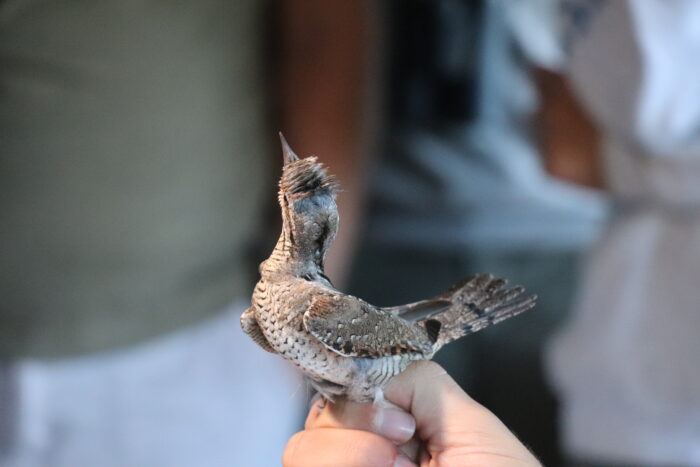For a birder in Malta, September is a special month. Unfortunately for my girlfriend, my beach season ends on the 31st of August. I have no problem maintaining my tan though, as from the 1st of September onwards I drag myself up to a hill above Buskett’s woodland every afternoon to watch the spectacle of autumn bird migration together with my birding friends.
From Buskett in September we mainly watch migrating birds of prey. Raptors, mainly Marsh Harriers and Honey-buzzards, pass in relatively high numbers over Malta during this period as they make their way towards Africa. Buskett is strategically placed in the southwestern coast of Malta and is an ideal place to watch raptors as they make use of rising hot air (thermals) to soar and gain height one last time before gliding towards Africa in the heat of September afternoons. Raptors that arrive late in the day often use Buskett as their roosting site for the night. From Buskett this autumn, over 2,800 birds of prey have been counted so far.
Apart from the regular species of birds of prey which include Ospreys, Black Kites, Marsh Harriers, Honey-buzzards, different falcons and Sparrowhawks, we are always on the lookout for rarer migrating birds. Over the past five weeks we spotted at least 11 Black Storks, one White Stork, one Booted Eagle, one Lesser Spotted Eagle and one Egyptian Vulture. Spotting one of these birds amongst a flock of soaring raptors gives any local birder an adrenaline rush that sends his heart pumping. On the other hand, getting a text saying that I’ve missed one of these birds whilst stuck in a meeting at work is what I dread the most!
Apart from raptors, September is also the peak for all other trans-Saharan migrants. These are the birds that cross the Sahara Desert as part of their migration and spend the winter in tropical Africa. This is a very long list of bird species, from small ones such as the Barn Swallow or large ones such as the Grey Heron. Because of this we monitor migration in areas that offer different habitats. We do sea-watching to observe water birds such as herons and ducks migrating along our coasts, we bird in garigue and valleys to observe land-birds such as Wheatears and Hoopoes and we of course monitor our nature reserves.

Għadira, Simar and Salina Nature Reserves offer the opportunity to watch migrating birds that need wetland habitat to be able to feed and rest. Waders, for example, are a family of birds which are easy to observe in the reserves but are quite scarce in other areas due to the lack of habitat. It is not a rare sight to see a flock of Wood Sandpipers come down like bullets from the sky and fill Għadira with their piping calls as they run around the shores of the small islands in search for small invertebrates to feed on.
The end of September usually marks the time when trans-Saharan migrants start slowing down but this does not mean that bird migration has ended. October and November bring with them the migration of birds that are more resistant to cold weather and spend the winter in southern Europe or North Africa. Smaller birds include the famous Robin, a species of which thousands of specimens migrate over Malta in the last week of October. Larger birds include Cormorants and later on Cranes. So until there’s enough daylight, traffic permitting, every day after work we still go out to spot migrating birds.

But why do we spend all this time watching and counting migrating birds? Birds are an important part of the ecology. They lie within various levels of the food chain and are therefore very good indicators of the well-being of the ecosystems they make part of. An effective way of monitoring passerine (small) birds is bird ringing. Bird ringing helps estimate numbers of small birds within an area more accurately. Collecting data year in and year out lets us compare numbers and see population fluctuations. We can see trends and note how environmental factors such as the weather affects migration. Over the years we’ve seen migrating birds such as the Bee-eater increase drastically and others such as the Turtle Dove almost disappear. Having such data at hand helps BirdLife Malta prioritize its work and guide authorities to take decisions based on scientific data.
To celebrate the spectacle of autumn bird migration and help its members and the general public to appreciate the importance of bird studies, BirdLife Malta participates in the EuroBirdwatch event that is held around Europe by different BirdLife partners every year on the first weekend of October. During this weekend, people from all around Europe go out in the countryside to count as many migrating birds as possible. BirdLife partners in 44 different countries organized a total of 1,080 events as part of EuroBirdwatch 2019. 29,000 people attended these events and counted over 4.2 million birds.

In Malta, BirdLife Malta invited people to join a bird ringing session at Għadira Nature Reserve on Saturday morning. Strong winds slowed the migration of passerine birds down but a nice selection of birds was caught and could be observed up close by the people present. The peculiar Wryneck, the only member of the woodpecker family that visits our archipelago, was the star of the show. On Sunday afternoon, members of the public joined birders at Buskett where they observed a good number of migrating raptors. An Osprey; a large raptor that feeds exclusively on fish, a Merlin; the smallest falcon of Europe and a rare Lesser Spotted Eagle were the highlights of the afternoon.
Autumn bird migration continues, albeit at a slower pace. Today, the 12th of October, reminds us of this and it is an occasion to celebrate this wonderful natural phenomenon. So Happy World Migratory Bird Day 2019!
By Nicholas Galea, BirdLife Malta bird ringer

